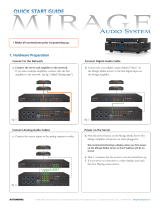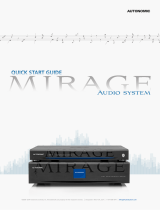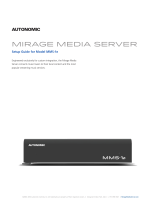Page is loading ...

051017
©2006–2017 Autonomic Controls, Inc. Autonomic and TuneBridge are registered trademarks of Autonomic Controls, Inc.
All other trademarks are property of their respective owners.
®
compatible with all Mirage Amplifiers
programming guide
URC Driver v1.0
for Mirage Amplifier
m-801e
m-401e
m-120e

URC Driver v1.0 for Mirage Media Server | 2 of 20
MirageAudioSystem.com
Quick Start
To quickly setup a system, follow these steps:
1. Add the driver for use in the URC Total Control environment.
2. Enter the IP address of the MAS.
3. Ensure that the drivers are bound properly according to the Conguration
section below.
Overview
The Autonomic URC v1.0 amplier driver allows for convenient programming of
all models of the Mirage ampliers in the URC Total Control System environment.
The Autonomic Mirage Amplier system offers up to 32 zones of audio in a Total
Control environment using one or more mirage ampliers.
Features
Version 1.0 of the mirage amplier driver integrates fully in the URC Total Control
system. It offers functionality for each output zone including event triggers and
queries of key properties. In addition, select ampliers can play content directly
from Autonomic MMS servers over the TCP-IP network.
Getting Started
Please verify that you are running the latest version of URC Accelerator software
and the Mirage Amplier rmware is up to date before proceeding.
You can check and update your rmware version on the MAS by going to the
Firmware tab on the server’s web conguration
(http://server-ip/cong/Software.aspx) or from the Autonomic
Dealer Zone company account associated with the MMS
(http://dealerzone.autonomic-controls.com). The latest URC Accelerator
software is available from the URC Dealer Portal for authorized
URC dealers. If you’re not an authorized dealer, please contact URC:
http://www.universalremote.com/contact_us.php

URC Driver v1.0 for Mirage Media Server | 3 of 20
MirageAudioSystem.com
Download the Drivers
All Mirage Amplier control drivers are available on the product page
on the SnapAV website or on the Autonomic Downloads page, found at
http://www.autonomic-controls.com/support_downloads.php.
To download the URC v1.0 Amplier Driver Suite, simply click on the link
labeled URC Amplier Suite v1.0 to start the download of the zip le.
INSIDE THE DOWNLOAD:
• Autonomic Amp v1.0.tcm
Details of Driver Communication
The central controller (MRX-8, MRX-10 and others) handles all communication
with the MAS and is responsible for relaying client commands. Each URC
client (such as TKP-7600, TRC-1080 and others) is capable of independently
controlling all the audio outputs on the MAS.
The MAS driver contains all the outputs available on the server, which are
capable of being mapped in the URC environment to different rooms or
inputs of another device.

URC Driver v1.0 for Mirage Media Server | 4 of 20
MirageAudioSystem.com
Conguration
REQUIREMENTS
This action informs the MAS server of the available outputs based on the
drivers present in the URC Total Control System program.
• TCM le: contains one-way and two-way driver including client interfaces
• URC Accelerator software
• Total Control System Hardware
• Mirage Amplier (M-801e, M-401e and M-120e)
CONFIGURING THE TOTAL CONTROL SYSTEM IN THE URC
ACCELERATOR
Note: The following steps illustrate a basic conguration of URC Total Control
System for Autonomic MAS. For more details or advanced setups, please refer
to URC Documentation.
1. Open the URC Accelerator software. Go to File tab > Import TCM Files. This
will open a browse dialog box. Navigate to the location where the .tcm le is
saved and click on Open to import the le.
Important: Please restart the URC Accelerator software by closing and re-launching it.

URC Driver v1.0 for Mirage Media Server | 5 of 20
MirageAudioSystem.com
2. On relaunching the URC Accelerator software, set up a new project by
going to File tab > New. This will automatically switch to Program tab with
1. Name & Location selected. Fill out Company Information and System
Information sections with desired data. Choose the Primary Controller Type
depending on your hardware.
If unsure, please contact URC support at:
http://www.universalremote.com/contact_us.php
Click on Save to Project Tree. A dialog box saying Sunrise/Sunset information is
invalid will show. Click on OK.
3. The Add Rooms tab will open under Program. Add additional rooms
depending on your setup.

URC Driver v1.0 for Mirage Media Server | 6 of 20
MirageAudioSystem.com
4. Go to Add URC Devices. This is for adding the existing URC Total Control
devices. Select the room in the Current Room menu on the left. Double-click
on a device, or click on Add to Room button on top left to add a device.
For some devices, a dialog box opens up showing advanced settings for the
device. Unless advanced setup is needed, leave default options selected and
click on Apply.
5. Go to Add Other Devices.
a. In the left pane under Select Room, select the desired room to add the
device to.
b. In Select Database, choose My.
c. In Select Module Type, choose IP Database.
d. In Select Category, choose Audio.
e. In Select Brand pane, choose Autonomic.
f. In Select Model pane, choose A-Series Amps or E-Series Amps to add
one at a time.
Note: One instance of the driver can run an amplier system up to 32 zones.
Note: To edit the names of your added devices, right-click on the device > Rename.
These are the names which show up in the menus and clients.

URC Driver v1.0 for Mirage Media Server | 7 of 20
MirageAudioSystem.com
Tip: If a display is connected, the MRX-20 gets stuck on loading screen when
a new project is pushed. To resolve this, a monitor needs to be added to the
project. This can be added to any room. In Add Other Devices, pick Database:
URC > IR Database > TV Category > and select a monitor from any brand (for
instance, Samsung if you have a Samsung monitor) > pick any model, and add
to project. Rename the device to Monitor for easy recognition. See step 7 for
conguring this monitor input.
6. Go to Network Setup. This section congures both URC and non-URC
devices (in this case, Mirage Amplier) with the current network address. As
a prerequisite, ensure all the devices are on the network with desired static
or DHCP conguration.
g. Click on tab URC Device. This will show all the currently added URC
devices in the project in the left pane. In this pane, click on the device
you want to congure the IP address for. Then click on the Refresh
button. This might take a small amount of time, after which it will show
you the discovered URC devices on the current network of currently
selected type in the right pane. Pick the device in the right pane with
the correct IP address. Then click on Assign button. If the devices are
not discovered, please ensure the actual device is on the network and is
switched on. Alternatively, you can also manually enter the MAC address
and IP addresses of your devices in the left pane.
h. Click on tab Non URC Device. This will show all the currently added
non-URC devices in the project in the left pane. If you previously added
Mirage Amplier to a room, its instance(s) should show up in the left
pane. Enter the IP Address for the amplier in the IP Address eld. Port
eld should already be lled with value 17037.

URC Driver v1.0 for Mirage Media Server | 8 of 20
MirageAudioSystem.com
7. Go to AV Inputs & Outputs tab. Click on the Inputs tab.
Here, available outputs of the MAS can be assigned to inputs of another
device (only if those devices have already been added to the project). The
available devices can be selected from Select Device with Inputs drop-down.
Drag the outputs from right pane to the left pane next to desired input of
currently selected device. Outputs assigned by accident can be deleted by
using the Delete Selected button. Next, click on Zone Assignment. Here, the
outputs can be assigned to different rooms.
Note: For e-series amps remote source assignment can be managed using the
procedure on page 9.
In Select Device with Outputs in the left pane, choose Mirage Amplier. Next,
from the right pane, drag the desired unassigned room to the appropriate
MAS output on the left pane.

URC Driver v1.0 for Mirage Media Server | 9 of 20
MirageAudioSystem.com
Note: The following procedures are only valid for setups that include e-series
products.
a. Initiate playback for all sources that will be used in URC in one of the
zones from the WebUI of the MMS.
b. Go to the conguration page for each MMS. Look for the ID or serial
number depending on the server model on the Firmware tab under license.
This is usually a 32 character hexadecimal string separated by dashes.
Note: This value will be used to identify the MMS on the ampliers.

URC Driver v1.0 for Mirage Media Server | 10 of 20
MirageAudioSystem.com
c. Go to the conguration WebUI for any amplier in the stack.
Congured remote sources are on the sources tab on the bottom right
under Assigned Sources.
d. Players on MMS are automatically added to the list when played. See step
a on page 10. Players are identied by Device: Mirage Media Server. The
Player's default name is shown under Source. In cases where several are
in the stack, hovering over the panel shows the license ID to identify the
MMS. Record the source number.
e. Physical input sources on the ampliers that have not been assigned
are available on the left in Available Sources. Drag the source from
Available Sources to Assigned Sources to use them with Total Control.
Record the source number.

URC Driver v1.0 for Mirage Media Server | 11 of 20
MirageAudioSystem.com
8. Go to Edit User Interfaces tab. Generate Menus & Devices is selected.
Advanced options can be edited through the Advanced button. With
default options selected, click on Accelerate button. You can choose to
leave the existing menus unchanged or erase all menus. If unsure, leave the
default option selected and click OK. Click on OK button on the Complete
Notication dialog box.

URC Driver v1.0 for Mirage Media Server | 12 of 20
MirageAudioSystem.com
The Edit Menus by Room tab is displayed next.
Optional: The menus for all rooms for either all devices or individual devices
can be edited here. Rooms can be selected in the Selected Room section and
device views can be selected in Select View section. On editing a menu, click
on Apply to save the changes.
Note: The MAS module is placed in the Settings menu by default. (Below
image shows sample menu with MAS module named to Autonomic Amplier
in the Settings menu).

URC Driver v1.0 for Mirage Media Server | 13 of 20
MirageAudioSystem.com
Optional: Congure the mapping of available MAS commands to hard
buttons.
Go to Edit Device Layouts. This screen allows conguration of commands
triggered on hard button presses. On Select Device Layout drop-down menu
on the left, select Autonomic Amplier. In Select View, Universal Layout is
selected by default, which means the conguration for all clients is being
edited. To edit hard button conguration for only a specic client, you can
select the specic device from the drop-down menu here.
All Hard Buttons section shows all hard buttons and their currently assigned
commands. Use Previous and Next page buttons to ip through all available
hard buttons. Menu Pages section shows commands currently unassigned to
any button. To change commands assigned to a hard button, simply drag a
command to the new button. You can modify existing commands by dragging
from one button to another, or assign new commands by dragging unassigned
commands from Menu Pages section to an empty button.
Click on Apply to save changes.

URC Driver v1.0 for Mirage Media Server | 14 of 20
MirageAudioSystem.com
9. Go to the Macro Editing tab. Leave the default options selected and click on
Accelerate. Click on OK on the Complete Notication dialog box.
Optional: For advanced macro editing, refer to URC documentation.
The driver provides event triggers for power, source, volume and mute status
changes programmable per zone. Triggers will execute a URC macro when the
programmed condition occurs
In tab 12. Macro Editing under Edit Automation Macros select Device Event
from Select Type of Automation Macro and click Add Macro.

URC Driver v1.0 for Mirage Media Server | 15 of 20
MirageAudioSystem.com
In the Device Event Dialog enter the following
• A descriptive name for the event in Name
• Select the device(Autonomic Amp)
• Select the Event rule to base the trigger on
• Type in and select the properties for the event that would cause the event
to trigger.
• Click OK to program the macro.
In the example below the trigger is set for when zone 1 of the amplier stack
is powered on.
Explanation of available Events:
Zone Power State Change event:
Parameters: name (example values), type of entry, notes
• Zone (1-32) input eld,
• New State (on, off, either) drop down menu, “Either” triggers both when
the zone is powered on and off
Zone Volume Change event:
Parameters: name (example values), type of entry, notes
• Zone (1-32), input eld
• Operator (any, less than, equals, greater than), drop down,
• Level (0-100), input eld, level to compare with the current volume level of
the amp

URC Driver v1.0 for Mirage Media Server | 16 of 20
MirageAudioSystem.com
Zone Mute Change event:
Parameters: name (example values), type of entry, notes
• Zone (1-32) input eld,
• New State (on, off, either) drop down menu, Either triggers both when the
zone is muted and unmuted
Zone Input Change:
Parameters: name (example values), type of entry, notes
• Zone (1-32), input eld
• New State (S1-S12, R1-32), drop down, Sx is a physical source. Rx is a remote
source (e-stream). Not all amp congurations will have all sources available.
Queries
The Driver provides queries for the power, source, volume and mute
status. Each programmed query is saved in a URC variable that can be
used to perform conditional programming in URC macros. A query can be
programmed to execute in any URC macro.
In any URC macro window, select the 2-way command button highlighted in
the following image.

URC Driver v1.0 for Mirage Media Server | 17 of 20
MirageAudioSystem.com
In the 2-way Module Command Dialog enter the following:
• A descriptive name for the query in Name
• Select the device (Autonomic Amp)
• Select the Command to query
• Enter the zone to query (1-32)
• The Description eld will describe the valid return values.
• power: 0=OFF, 1=ON
• volume: 0-100, -1 = failure
• mute: 0=OFF, 1=ON
• input: 1-8, 0=error
• Check the box Save the result
• Select an existing variable to save the result to in the Variable drop down, or
create a new variable of the correct type as specied after Save the result :
right above the drop down.
• Click OK to program the macro.

URC Driver v1.0 for Mirage Media Server | 18 of 20
MirageAudioSystem.com
The variable is now programmed and can be used for conditional
programming. The variables in Total Control are global and can be used
throughout the system. In the example macro below the variable is evaluated
in the same macro but this is not necessary.
TIP: Tracking changes of a property
Using both the event trigger and 2-way command query, variables can be set
up to always track a specic property, for example in the examples above to
track the power status of zone 1.
• Create a device event to trigger for either power state change for zone 1.
• Query zone 1 power status in the macro for the device event and save to a
variable.
10. The MAS zone output has been set in step 7, so the Punch Through setting
by default is the volume setting for all devices in the room.

URC Driver v1.0 for Mirage Media Server | 19 of 20
MirageAudioSystem.com
Note: By default, the Amplier zone is punch-through for volume, and mute
for the whole room setting.
11. Go to Download tab. If the accelerator project has not been saved yet,
a prompt will be shown to save it now. Click on OK on the next prompt.
A download screen will be shown with a list of all URC devices added to
the project. This will push the current project to the primary controller
and clients. Select the devices you want to download to and click on
Download to Select Devices (Direct).

URC Driver v1.0 for Mirage Media Server | 20 of 20
MirageAudioSystem.com
Tip: Occasionally, download fails to select clients like remotes and
touchpanels. For instance, the panel drops WiFi if screen is not on or if the
remote is not charged. Touch the screen to switch it on, or place the remote
on charger and try to download again.
12. Go to Download tab. If the accelerator project has not been saved yet,
a prompt will be shown to save it now. Click on OK on the next prompt.
A download screen will be shown with a list of all URC devices added to
the project. This will push the current project to the primary controller
and clients. Select the devices you want to download to and click on
Download to Select Devices (Direct).
Technical Support
If you require further assistance with conguring the URC Driver Suite v1.0
for the Mirage Amplier, please contact Technical Support at
(866) 838-5052, or email techsupport@snapav.com. You can also visit the
Autonomic Knowledge base (http://www.autonomic-controls.com/kb) for
troubleshooting information and access to submitting a support ticket.
/


